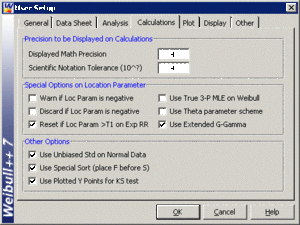Template:Normal distribution maximum likelihood estimation
Maximum Likelihood Estimation
As it was outlined in chapter Parameter Estimation, maximum likelihood estimation works by developing a likelihood function based on the available data and finding the values of the parameter estimates that maximize the likelihood function. This can be achieved by using iterative methods to determine the parameter estimate values that maximize the likelihood function. This can be rather difficult and time-consuming, particularly when dealing with the three-parameter distribution. Another method of finding the parameter estimates involves taking the partial derivatives of the likelihood function with respect to the parameters, setting the resulting equations equal to zero, and solving simultaneously to determine the values of the parameter estimates. The log-likelihood functions and associated partial derivatives used to determine maximum likelihood estimates for the normal distribution are covered in Appendix: Distribution Log-Likelihood Equations.
Special Note About Bias
Estimators (i.e. parameter estimates) have properties such as unbiasedness, minimum variance, sufficiency, consistency, squared error constancy, efficiency and completeness [7][5]. Numerous books and papers deal with these properties and this coverage is beyond the scope of this reference.
However, we would like to briefly address one of these properties, unbiasedness. An estimator is said to be unbiased if the estimator [math]\displaystyle{ \widehat{\theta }=d({{X}_{1,}}{{X}_{2,}}...,{{X}_{n)}} }[/math] satisfies the condition [math]\displaystyle{ E\left[ \widehat{\theta } \right] }[/math] [math]\displaystyle{ =\theta }[/math] for all [math]\displaystyle{ \theta \in \Omega . }[/math]
Note that [math]\displaystyle{ E\left[ X \right] }[/math] denotes the expected value of X and is defined (for continuous distributions) by:
- [math]\displaystyle{ \begin{align} E\left[ X \right]= \int_{\varpi }x\cdot f(x)dx \\ X\in & \varpi . \end{align} }[/math]
It can be shown [7][5] that the MLE estimator for the mean of the normal (and lognormal) distribution does satisfy the unbiasedness criteria, or [math]\displaystyle{ E\left[ \widehat{\mu } \right] }[/math] [math]\displaystyle{ =\mu . }[/math] The same is not true for the estimate of the variance [math]\displaystyle{ \hat{\sigma }^{2} }[/math] . The maximum likelihood estimate for the variance for the normal distribution is given by:
- [math]\displaystyle{ \hat{\sigma }^{2}=\frac{1}{N}\underset{i=1}{\overset{N}{\mathop \sum }}\,{{({{t}_{i}}-\bar{T})}^{2}} }[/math]
with a standard deviation of:
- [math]\displaystyle{ {{\hat{\sigma }}}=\sqrt{\frac{1}{N}\underset{i=1}{\overset{N}{\mathop \sum }}\,{{({{t}_{i}}-\bar{T})}^{2}}} }[/math]
These estimates, however, have been shown to be biased. It can be shown [7][5] that the unbiased estimate of the variance and standard deviation for complete data is given by:
- [math]\displaystyle{ \begin{align} \hat{\sigma }^{2}= & \left[ \frac{N}{N-1} \right]\cdot \left[ \frac{1}{N}\underset{i=1}{\overset{N}{\mathop \sum }}\,{{({{t}_{i}}-\bar{T})}^{2}} \right]=\frac{1}{N-1}\underset{i=1}{\overset{N}{\mathop \sum }}\,{{({{t}_{i}}-\bar{T})}^{2}} \\ {{{\hat{\sigma }}}}= & \sqrt{\left[ \frac{N}{N-1} \right]\cdot \left[ \frac{1}{N}\underset{i=1}{\overset{N}{\mathop \sum }}\,{{({{t}_{i}}-\bar{T})}^{2}} \right]} \\ = & \sqrt{\frac{1}{N-1}\underset{i=1}{\overset{N}{\mathop \sum }}\,{{({{t}_{i}}-\bar{T})}^{2}}} \end{align} }[/math]
Note that for larger values of [math]\displaystyle{ N }[/math] , [math]\displaystyle{ \sqrt{\left[ N/(N-1) \right]} }[/math] tends to 1.
The Use Unbiased Std on Normal Data option in the User Setup under the Calculations tab allows biasing to be considered when estimating the parameters.
When this option is selected, Weibull++ returns the unbiased standard deviation as defined. This is only true for complete data sets. For all other data types, Weibull++ by default returns the biased standard deviation as defined above regardless of the selection status of this option. The next figure shows this setting in Weibull++.
[math]\displaystyle{ }[/math]
